Five days after it first plowed into southwest Texas as a category 4 hurricane, Tropical Storm Harvey has made second landfall west of Cameron on the border between Texas and Louisiana, early Wednesday according to the National Hurricane Center. The storm, which has already pummeled the city of Houston with more than 50 inches of rain – a new record for the contiguous US, according to the Wall Street Journal – has left at least 18 dead, including two Houston police officers, and forced tens of thousands of people from their homes.
Though the hurricane (now tropical storm) has wreaked widespread devastation on Texas, Reuters says citizens of Western Louisiana have at least one silver lining to cling to: torrential rains are expected to cease later on Wednesday as the storm picks up speed and moves northeast away from the Gulf of Mexico. NOAA was forecasting less than an inch of rain for the Houston area on Wednesday, with a slight chance of sunshine.
“Harvey, which made landfall west of Cameron, Louisiana on Wednesday, was expected to produce an additional 3 to 6 inches (7.5 to 15.24 cms) of rain to an area about 80 miles east of Houston as well as southwestern Louisiana, where some areas have already seen more than 17 inches of rain.
It is projected to weaken as it moves inland to the northeast, the National Hurricane Center said.
“We aren’t going to be dealing with it for too much longer. It’s going to pick up the pace and get out of here,” said Donald Jones, a meteorologist at the National Weather Service in Lake Charles, Louisiana.”
However, that’s hardly any consolation to residents of Houston and the surrounding Harris County, an area 15 times the size of Manhattan, one-third of which remains underwater, according to Reuters. It may take days for all flood waters, which have spilled over dams and pushed levees to their limits, to recede.
According to WSJ, Texas officials said 30,000 people could be forced from their homes due to flooding and more than 725,000 people were under a mandatory evacuation order. A convention center equipped to hold 5,000 people was housing over 9,000 evacuees by midday Tuesday.
Last night, Houston Mayor Sylvester Turner ordered a curfew from midnight to 5 am local time to prevent looting and keep the streets clear for first responders.
CURFEW UPDATE: I’m modifying the curfew to start at midnight (and still end at 5 am) to allow volunteers and others to do their great work.
— Sylvester Turner (@SylvesterTurner) August 30, 2017
One women who spoke to WSJ compared Harvey with a biblical flood.
“I asked my daughter, is this the end of the world?” said 74-year-old Norma Brown, cradling two of her dogs in a Houston evacuation center after fleeing the flood on a neighbor’s boat. While waiting in the rain to get into the George R. Brown Convention Center downtown, Ms. Brown burst into tears, realizing she had likely lost her home in Dickinson, a badly flooded area southeast of the city.”
The Pentagon said Tuesday it has identified as many as 30,000 troops to assist in a massive military response, and was awaiting a formal request for assistance from Mr. Abbott, who has already activated 12,000 Texas national guardsmen to help with the state’s response to the hurricane. Federal and local agencies said they’ve already rescued more than 13,000 people from floodwaters in Houston and the surrounding area, according to ABC.
More than four feet of rainfall has badly damaged Houston’s infrastructure, causing one bridge to collapse, as we reported yesterday. Two reservoirs in and around the city were already overflowing, and authorities warned that water levels at a third reservoir were nearing their top.
According to Bloomberg, Harvey has created a situation where Gulf of Mexico waters have kept drumming hard up against the coastline, preventing rain water from running off into the sea and backing everything up for miles around.
The ferocious arrival was tempered by high-pressure systems across the U.S., including a large one that pushed temperatures in California beyond 100 degrees Fahrenheit (38 Celsius), said Phil Klotzbach, a hurricane researcher at Colorado State University. Harvey became “a pebble in stagnant stream.”
Predictions were that some areas east of Houston would witness 50 inches or more of rain by the time Harvey moved off into the central U.S. As of 3 a.m. local time Wednesday, the gauge at Mont Belvieu, east of the city, showed 51.88 inches had fallen since the start of the storm. That may be the most in recorded history for a tropical cyclone in the contiguous U.S., breaking a mark also set in Texas back in 1978. The record for all 50 states in such a storm was set in 1950 in Hawaii — 52 inches.
Harvey’s deluge was made all the worse because the ground was already saturated by heavy rainfall earlier in the season. “We have had roughly a year’s worth of rain in the last three months,” said Wendy Wong, a National Weather Service meteorologist in Dickinson, Texas, a city that was evacuated.
* * *
“We’re on the verge of having cascading failures,” said Watson, a Savannah, Georgia-based disaster modeler with Enki Research. “It is conceivable that we could get into the $60 to $80 billion range without that much effort.” Watson said disaster models just aren’t calibrated for a thing like Harvey. For instance, a typical scenario will assume infrastructure such as dams, levees and drainage systems will fail when stress rates reach 80 to 90 percent. “We are seeing failures at 60 percent,” he said.
The pressure on the Addicks and Barker reservoirs west of Houston spurred the Army Corps of Engineers to release water, which flooded neighborhoods that had been dry before. Now such deliberate flooding should be more calculated, Watson said.
“We’re starting to get into the apocalyptic — this is what we don’t want to have happen,” Watson said.
While we wait for the apocalypse, Houston’s largest shelter, the George R. Brown Convention Center, held more than 9,000 people as of Wednesday, almost twice the number officials originally planned to house there. Mayor Turner said the city was working on opening two more shelters, adding that nobody would be turned away.
Meanwhile, Texas Gov. Greg Abbott told ABC News’ “Good Morning America” on Monday that he expects the aftermath of Harvey to be “horrific” and that it will “take years” to rebuild. As reported last night, a nighttime curfew, from 10 p.m. to 5 a.m., was imposed in Houston Tuesday night as the storm’s center drifted back toward the Gulf of Mexico. The storm made landfall between Port Aransas and Port O’Connor in Texas on Friday, stalled out further inland over the weekend and is now trekking eastward. It is expected to reach the Lower Mississippi Valley by Thursday.
Moody’s expects the storm to cause between $30 and $40 billion in property damage, which would make Harvey the fourth most severe hurricane to ever hit the US. Some have estimated as much as $100 billion in damages.
As the storm leaves Texas and Louisiana behind late Wednesday, it’s expected to move across the Lower Mississippi Valley and Tennessee Valley through Thursday. The forecast calls for the storm to continue into the central U.S., and it’s expected to become a tropical depression by tonight.
Even then, Houston won’t be free from threats: rainfall over the state will eventually need to make its way into the Gulf, which means several more pulses of water could be coming the city’s way, Watson said.
“There is another train that is heading toward Houston,” Watson said. “Behind every one of these dollar signs is a family that doesn’t have a house anymore.”
Source Article from http://feedproxy.google.com/~r/blacklistednews/hKxa/~3/_zwNGkFHNcA/M.html
Related posts:
Views: 0
 RSS Feed
RSS Feed

















 August 30th, 2017
August 30th, 2017  Awake Goy
Awake Goy 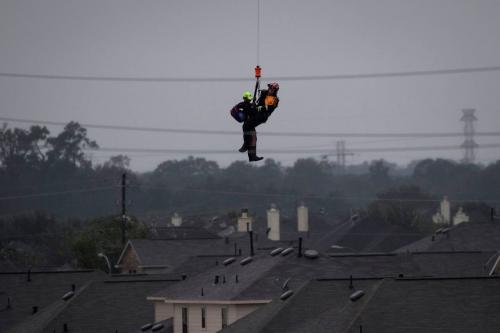
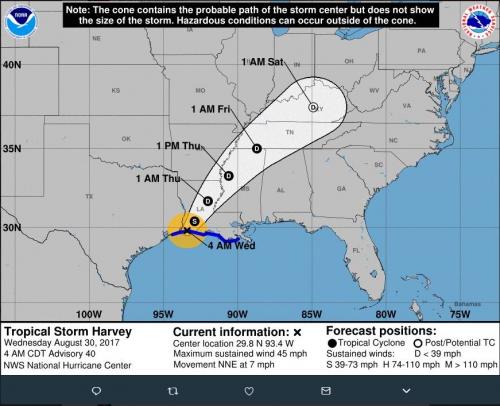
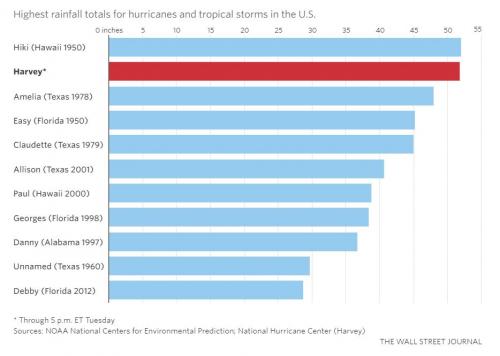
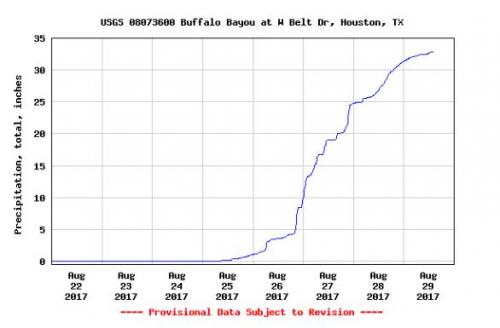
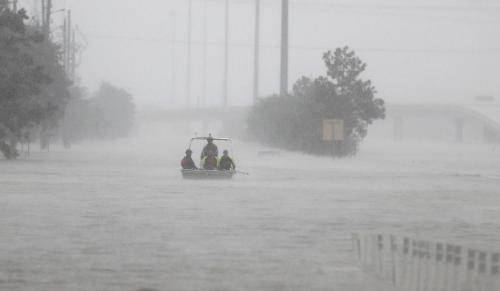
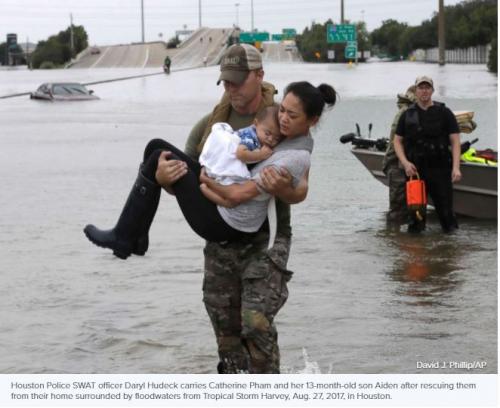
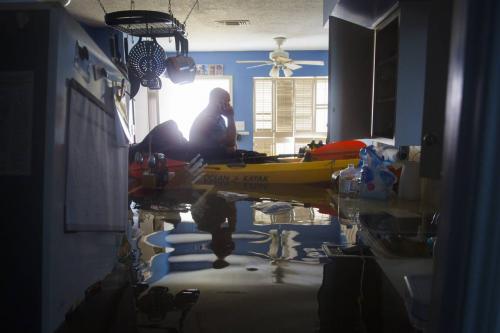
 Posted in
Posted in  Tags:
Tags: 
















